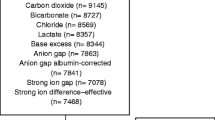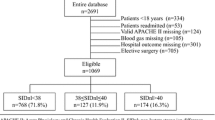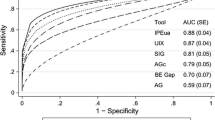Abstract
Objective: To evaluate the sensitivity, specificity, and predictive values of an elevated anion gap as an indicator of hyperlactatemia and to assess the contribution of blood lactate to the serum anion gap in critically ill patients. Design: Prospective study. Setting: General intensive care unit of a university hospital. Patients: 498 patients, none with ketonuria, severe renal failure or aspirin, glycol, or methanol intoxication. Measurements and results: The anion gap was calculated as [Na+] − [Cl−] − [TCO2]. Hyperlactatemia was defined as a blood lactate concentration above 2.5 mmol/l. The mean blood lactate concentration was 3.7 ± 3.2 mmol/l and the mean serum anion gap was 14.3 ± 4.2 mEq/l. The sensitivity of an elevated anion gap to reveal hyperlactatemia was only 44 % [95 % confidence interval (CI) 38 to 50], whereas specificity was 91 % (CI 87 to 94) and the positive predictive value was 86 % (CI 79 to 90). As expected, the poor sensitivity of the anion gap increased with the lactate threshold value, whereas the specificity decreased [for a blood lactate cut-off of 5 mmol/l: sensitivity = 67 % (CI 58 to 75) and specificity = 83 % (CI 79 to 87)]. The correlation between the serum anion gap and blood lactate was broad (r 2 = 0.41, p < 0.001) and the slope of this relationship (0.48 ± 0.026) was less than 1 (p < 0.001). The serum chloride concentration in patients with a normal anion gap (99.1 ± 6.9 mmol/l) was comparable to that in patients with an elevated anion gap (98.8 ± 7.1 mmol/l). Conclusions: An elevated anion gap is not a sensitive indicator of moderate hyperlactatemia, but it is quite specific, provided the other main causes of the elevated anion gap have been eliminated. Changes in blood lactate only account for about half of the changes in anion gap, and serum chloride does not seem to be an important factor in the determination of the serum anion gap.
Similar content being viewed by others
Author information
Authors and Affiliations
Additional information
Received: 22 May 1996 Accepted: 13 January 1997
Rights and permissions
About this article
Cite this article
Levraut, J., Bounatirou, T., Ichai, C. et al. Reliability of anion gap as an indicator of blood lactate in critically ill patients. Intensive Care Med 23, 417–422 (1997). https://doi.org/10.1007/s001340050350
Issue Date:
DOI: https://doi.org/10.1007/s001340050350




